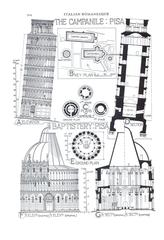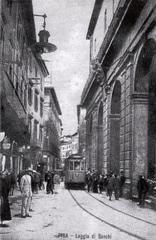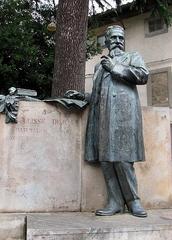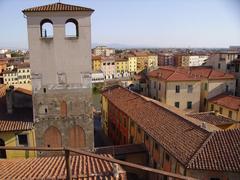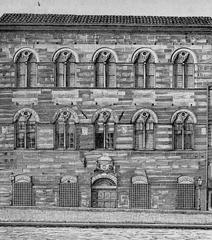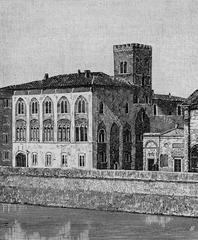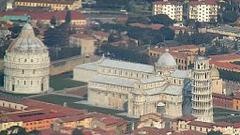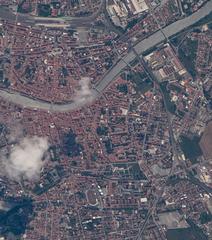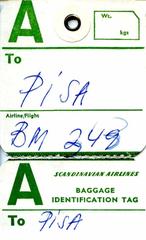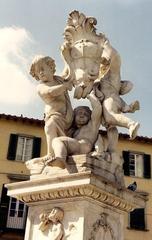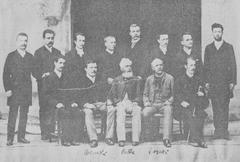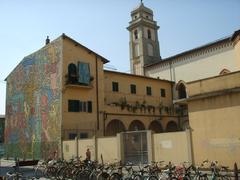Visiting Palazzo della Carovana in Pisa: Hours, Tickets, and Tips
Date: 01/08/2024
Introduction
The Palazzo della Carovana, situated in the historical Knights’ Square (Piazza dei Cavalieri) in Pisa, Italy, stands as a remarkable testament to the city’s rich architectural and cultural heritage. Originally conceived in the medieval period as the Palazzo degli Anziani (Palace of the Elders), this iconic building has undergone significant transformations, most notably during the Renaissance under the direction of the acclaimed architect Giorgio Vasari (Turismo Pisa). Commissioned by Duke Cosimo I de’ Medici in 1558 to serve as the headquarters for the Knights of St. Stephen, Vasari’s redesign imbued the structure with a harmonious blend of Renaissance symmetry and Baroque grandeur, creating a visually striking façade adorned with intricate sgraffito decorations and allegorical figures (Wikipedia) (Forever Vacation).
Today, the Palazzo della Carovana is not only a symbol of Pisa’s historical evolution but also an active center of academic excellence, housing the prestigious Scuola Normale Superiore di Pisa since 1846 (Forever Vacation). Visitors can explore its grand halls, intricate facades, and ceremonial spaces that resonate with a rich legacy of military, educational, and cultural significance. This article serves as a comprehensive guide to visiting Palazzo della Carovana, detailing its historical context, architectural highlights, visitor information, and practical tips for an enriching experience.
Table of Contents
- [Historical Background](#historical-backgroundhistorical-background)
- [Origins and Early History](#origins-and-early-historyorigins-and-early-history)
- [Renaissance Transformation](#renaissance-transformationrenaissance-transformation)
- [Architectural Features](#architectural-featuresarchitectural-features)
- [The Knights of St. Stephen](#the-knights-of-st-stephenthe-knights-of-st-stephen)
- [Later Developments](#later-developmentslater-developments)
- [The Scuola Normale Superiore di Pisa](#the-scuola-normale-superiore-di-pisathe-scuola-normale-superiore-di-pisa)
- [Cultural and Historical Significance](#cultural-and-historical-significancecultural-and-historical-significance)
- [Preservation and Restoration](#preservation-and-restorationpreservation-and-restoration)
- [Visitor Experience](#visitor-experiencevisitor-experience)
- [Visitor Information](#visitor-informationvisitor-information)
- [Visiting Hours and Tickets](#visiting-hours-and-ticketsvisiting-hours-and-tickets)
- [Travel Tips](#travel-tipstravel-tips)
- [Nearby Attractions](#nearby-attractionsnearby-attractions)
- [Accessibility](#accessibilityaccessibility)
- [FAQ Section](#faq-sectionfaq-section)
- [Frequently Asked Questions](#frequently-asked-questionsfrequently-asked-questions)
- [Conclusion](#conclusionconclusion)
- [References](#referencesreferences)
Historical Background
Origins and Early History
The Palazzo della Carovana, also known as Palazzo dei Cavalieri, is a significant historical building located in Knights’ Square (Piazza dei Cavalieri) in Pisa, Italy. The palace’s origins date back to the medieval period when it was initially a tower known as the Palazzo degli Anziani (Palace of the Elders). This tower can still be seen on the south side of Via Consoli del Mare (Turismo Pisa).
Renaissance Transformation
The transformation of the Palazzo della Carovana into its current form began in the mid-16th century. In 1558, Duke Cosimo I de’ Medici decided to establish the seafaring military order of the Knights of St. Stephen and needed a headquarters for the order. The task of renovating the existing structure was entrusted to Giorgio Vasari, a renowned architect and artist of the Renaissance period (Wikipedia).
Vasari visited Pisa in 1561 to study the square and the position of the buildings. By 1564, the renovation was complete, and the knights had moved into the new headquarters. Vasari’s design aimed to create a symmetrical building that achieved an effect of evenness and harmony. He used pictorial decoration and stonework to give rhythm to the facade and mask the differences among the old buildings (Turismo Pisa).
Architectural Features
The facade of the Palazzo della Carovana is one of its most striking features. It is characterized by a complex scheme of sgraffiti, representing allegorical figures and zodiacal signs. These designs were created by Vasari himself and sculpted by Tommaso di Battista del Verrocchio and Alessandro Forzori. The current paintings on the facade date back to the 19th and 20th centuries (Wikipedia).
Among the sculptures adorning the facade are the Medici Coat of Arms and that of the Knights, flanked by the allegories of Religion and Justice by Stoldo Lorenzi (1563). The upper gallery features busts of the Grand Dukes of Tuscany, who were also the Grand Masters of the Order. These busts were added in the late 16th to early 18th centuries and were sculpted by Ridolfo Sirigatti, Pietro Tacca, and Giovan Battista Foggini (Wikipedia).
The Knights of St. Stephen
The Knights of St. Stephen, for whom the Palazzo della Carovana was renovated, played a crucial role in the history of Pisa and the broader region. The order was established by Duke Cosimo I de’ Medici in 1561 to defend the Mediterranean from Ottoman and pirate incursions. The knights underwent a rigorous three-year training period known as “la Carovana,” which is the origin of the palace’s name (Wikipedia).
Later Developments
In 1821, the double-ramp staircase of the palace was remade, adding to its architectural grandeur. The rear area of the building saw a modern addition between 1928 and 1930 to accommodate the needs of the Scuola Normale Superiore di Pisa, which has been housed in the palace since 1846 (Wikipedia).
The Scuola Normale Superiore di Pisa
The Scuola Normale Superiore di Pisa is one of Italy’s most prestigious educational institutions. Founded in 1810 by Napoleon Bonaparte, the school has a rich history of academic excellence and has produced numerous notable alumni. The Palazzo della Carovana serves as the main building of this esteemed institution, further cementing its importance in Pisa’s cultural and intellectual landscape (Forever Vacation).
Cultural and Historical Significance
The Palazzo della Carovana is not just an architectural marvel; it is a symbol of Pisa’s transition from a maritime republic to a center of cultural renaissance and learning. The building encapsulates a fragment of Pisa’s soul, representing a lineage of knowledge and prestige. It stands as a testament to the Medici family’s influence on Pisa and the power of education in shaping modern Italy (Forever Vacation).
Preservation and Restoration
Over the centuries, the Palazzo della Carovana has undergone various restoration efforts to preserve its historical and architectural integrity. The sgraffito decorations on the facade, originally based on sketches by Vasari, have been vastly restored to maintain their intricate details. These efforts ensure that the palace continues to be a significant cultural and historical landmark in Pisa (Turismo Pisa).
Visitor Experience
Today, visitors to the Palazzo della Carovana can explore its rich history and architectural beauty. The palace is open to the public, and certain areas may be accessible during special events or by special arrangement. Visitors can admire the Renaissance architecture, the elaborate facade with sgraffiti, and the classical statues that adorn the building. The grand hall and courtyards are often used for cultural events and exhibitions, providing a glimpse into the palace’s historical significance (Forever Vacation).
Visitor Information
Visiting Hours and Tickets
- Visiting Hours: The Palazzo della Carovana is open to visitors Monday through Friday from 9:00 AM to 6:00 PM. Weekend hours may vary, so it is advisable to check the official website before planning your visit.
- Tickets: Admission to the palazzo is free of charge. However, guided tours may have a fee, and it is recommended to book in advance, especially during peak tourist seasons.
Travel Tips
- Guided Tours: Consider joining a guided tour to gain deeper insights into the building’s history and architectural features. Knowledgeable guides can provide fascinating anecdotes and historical context that you might miss on a self-guided tour.
- Photography: The palazzo’s façade and interior are highly photogenic. Don’t forget to bring your camera to capture the intricate details and stunning architectural elements.
- Library and Archives: If you have a keen interest in history and academia, make sure to visit the Historical Archives and the library. These areas house valuable documents and artifacts that offer a deeper understanding of the palazzo’s significance.
- Timing: Plan your visit during weekdays when the university is in session to experience the vibrant academic atmosphere. However, be mindful of the university’s schedule and any restricted areas.
Nearby Attractions
- Leaning Tower of Pisa: Just a short walk from Palazzo della Carovana, the iconic Leaning Tower of Pisa is a must-visit landmark.
- Piazza dei Miracoli: This historic square features several notable attractions, including the Pisa Cathedral and the Baptistery.
- Museo dell’Opera del Duomo: Explore this museum to view an impressive collection of art and artifacts related to Pisa’s religious history.
Accessibility
- Wheelchair Access: Palazzo della Carovana is partially accessible to wheelchair users. Some areas may have limited access, so it is advisable to contact the administration in advance for specific accessibility information.
- Facilities: The palazzo is equipped with basic facilities, including restrooms and seating areas for visitors.
FAQ Section
Frequently Asked Questions
Q: What are the visiting hours for Palazzo della Carovana? A: The palazzo is open Monday through Friday from 9:00 AM to 6:00 PM. Weekend hours may vary.
Q: Is there an admission fee to enter Palazzo della Carovana? A: Admission is free, but guided tours may have a fee.
Q: Can I take photographs inside Palazzo della Carovana? A: Yes, photography is allowed, and the building’s interior and exterior are highly photogenic.
Q: Are there guided tours available? A: Yes, guided tours are available and recommended for a deeper understanding of the palazzo’s history and architecture.
Q: How can I access the Historical Archives and library? A: Visitors can access these areas during regular visiting hours. It is advisable to check in advance for any restricted areas or special requirements.
Conclusion
The Palazzo della Carovana encapsulates the essence of Pisa’s historical and cultural journey, transitioning from a medieval tower to a Renaissance masterpiece and a modern educational institution. Its architectural splendor, characterized by Vasari’s intricate sgraffito designs and the grand statues of the Medici family, coupled with its rich historical significance as the headquarters of the Knights of St. Stephen, make it a must-visit landmark for history enthusiasts and architectural aficionados alike (Wikipedia). The building’s current role as the main structure of the Scuola Normale Superiore di Pisa underscores its ongoing contribution to education and intellectual advancement, ensuring that it remains a vibrant and integral part of Pisa’s cultural fabric (Forever Vacation).
As you plan your visit, take advantage of the guided tours and explore the various halls and courtyards that offer a glimpse into the palazzo’s storied past. Remember to check the visiting hours and ticket information to make the most of your trip. Whether you are drawn by its historical allure, architectural beauty, or academic significance, the Palazzo della Carovana promises an unforgettable experience that bridges the past and present, encapsulating the enduring legacy of one of Pisa’s most iconic landmarks.
References
- Turismo Pisa (n.d.) Palazzo dei Cavalieri di Santo Stefano - Palazzo della Carovana. source
- Wikipedia (n.d.) Palazzo della Carovana. source
- Forever Vacation (n.d.) Palazzo della Carovana, Pisa. source
- Forza Pisa (2024) History and Architecture of Palazzo della Carovana. source
- Scuola Normale Superiore (n.d.) Palazzo della Carovana. source
- Pisa Tour (n.d.) The Palazzo dei Cavalieri. source
- Salt in Our Hair (n.d.) Pisa. source

